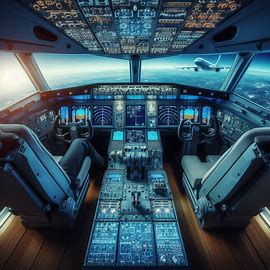
Introduction
The cockpit is the command center of any aircraft, where pilots interact with complex systems to ensure safe and efficient flight operations. Over the decades, cockpit technology has evolved dramatically, integrating advanced avionics, automation, and ergonomic designs that reduce pilot workload and enhance situational awareness. Today’s most advanced commercial aircraft cockpits represent the pinnacle of aeronautical engineering and digital innovation. This article delves into the key features of these cockpits, examines leading aircraft models, explores the technology behind them, and looks toward future developments transforming commercial aviation.
1. Evolution of Commercial Aircraft Cockpits
1.1 From Analog to Digital: The Journey of Cockpit Technology
Cockpit technology has undergone a remarkable transformation since the early days of aviation. Initially dominated by analog gauges and manual controls, cockpits now rely on digital displays and integrated systems. This shift began in the 1970s with the introduction of “glass cockpits”—cockpits featuring electronic flight instrument systems (EFIS) that replaced traditional dials with digital screens.
-
Early cockpits featured round-dial instruments.
-
Glass cockpits introduced multifunction displays (MFDs).
-
Modern cockpits integrate automated flight management systems (FMS) and fly-by-wire controls.
This evolution has significantly improved pilot situational awareness, safety, and operational efficiency.
1.2 Impact of Automation and Human Factors
Automation plays a crucial role in modern cockpits by assisting pilots with navigation, flight control, and systems management. However, human factors engineering is equally important, ensuring that technology supports rather than overwhelms pilots. Cockpit interfaces today are designed with ergonomic principles, intuitive displays, and alerting systems that aid decision-making under stress.
2. Core Components of Advanced Commercial Aircraft Cockpits
2.1 Avionics and Flight Instruments
Modern cockpits utilize integrated avionics suites that combine multiple sensors and data sources into coherent displays. Key components include:
-
Primary Flight Display (PFD): Shows critical flight data like attitude, airspeed, altitude, and heading.
-
Navigation Display (ND): Provides situational awareness of the aircraft’s position, route, and nearby traffic.
-
Flight Management System (FMS): Automates navigation, performance optimization, and fuel management.
-
Autopilot and Auto-throttle Systems: Enable automatic control of aircraft flight path and engine thrust.
The integration of these components allows pilots to manage complex operations with greater precision.
2.2 Fly-by-Wire Control Systems
Fly-by-wire (FBW) technology replaces traditional mechanical flight control linkages with electronic signals. This system enhances flight stability, reduces weight, and allows for flight envelope protection that prevents the aircraft from exceeding safe operational limits.
-
FBW provides smoother control inputs.
-
Improves fuel efficiency by optimizing flight paths.
-
Enables advanced features such as automatic stall recovery.
FBW is a hallmark of many modern commercial aircraft, including the Airbus A350 and Boeing 787.
3. Leading Examples of Advanced Cockpits in Modern Commercial Aircraft
3.1 Airbus A350 XWB Cockpit
The Airbus A350 XWB features one of the most advanced cockpits in commercial aviation, combining ergonomic design with cutting-edge avionics.
-
Large, high-resolution LCD screens provide customizable flight information.
-
Enhanced vision systems improve pilot awareness in low visibility.
-
Head-Up Display (HUD) projects critical data directly onto the pilot’s line of sight.
-
Integrated FMS supports optimized flight planning and fuel efficiency.
The A350’s cockpit design focuses on reducing pilot workload and improving situational awareness during all phases of flight.
3.2 Boeing 787 Dreamliner Cockpit
The Boeing 787 Dreamliner cockpit exemplifies the latest in digital avionics and automation.
-
Dual large LCD displays show flight and navigation data.
-
Synthetic vision systems provide 3D terrain visualization.
-
Advanced weather radar with turbulence detection.
-
Fly-by-wire controls combined with a sophisticated autopilot system enhance handling.
Boeing’s emphasis on pilot-centered design contributes to safer and more efficient operations worldwide.
4. Enhancements in Safety and Efficiency through Cockpit Technology
4.1 Real-Time Data and Connectivity
Modern cockpits leverage real-time data connectivity, enabling communication with ground control and access to live weather updates, traffic information, and system diagnostics.
-
Data link communications improve situational awareness.
-
Predictive analytics assist in maintenance planning.
-
Enhanced coordination with air traffic control (ATC) reduces delays and fuel consumption.
4.2 Ergonomics and Pilot Workload Reduction
Innovative cockpit layouts and interface designs minimize pilot fatigue and errors. Features include:
-
Touchscreen controls alongside traditional buttons.
-
Voice recognition for system commands.
-
Automated alert prioritization to reduce distractions.
These advancements support longer flights and complex airspace navigation without compromising safety.
5. The Future of Commercial Aircraft Cockpits
5.1 Artificial Intelligence and Autonomous Systems
Emerging technologies promise to further revolutionize cockpits, including AI-assisted decision support and semi-autonomous flight capabilities. These systems aim to:
-
Enhance predictive maintenance.
-
Assist pilots in managing abnormal situations.
-
Potentially enable single-pilot operations for commercial flights.
5.2 Virtual and Augmented Reality
Virtual reality (VR) and augmented reality (AR) tools are being developed for pilot training and operational support, providing immersive situational awareness and interactive system monitoring.
5.3 Enhanced Human-Machine Interfaces
Future cockpits will likely feature more intuitive interfaces that adapt to pilot preferences and physiological states, ensuring optimal information delivery and reducing cognitive load.
Conclusion
The most advanced cockpits in modern commercial aircraft showcase the impressive fusion of technology, design, and human factors engineering. These innovations have not only improved flight safety and efficiency but have also transformed the pilot’s role in managing increasingly complex machines. As technology continues to evolve, the cockpit will become even smarter, more intuitive, and more autonomous. What future cockpit innovations are you most excited about? Join the discussion and share your insights on how these technologies will shape the next era of commercial aviation.